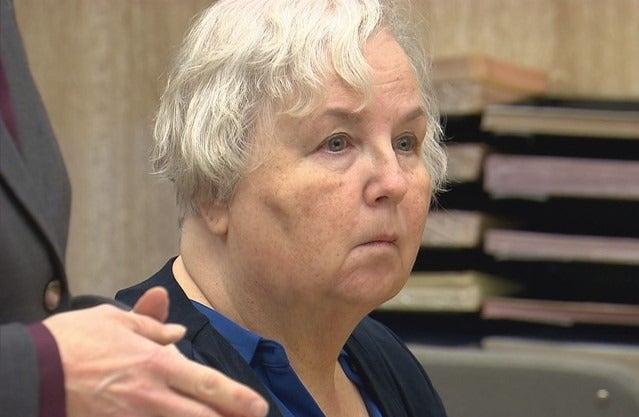Prosecutor says ‘How to Murder Your Husband’ novelist confessed to killing real-life husband
Authorities say Nancy Crampton-Brophy, 71, fatally shot her husband to collect $1.5m in insurance

The romance novelist who penned the infamous essay titled, “How to Murder Your Husband”, and who stands accused of fatally shooting her own husband in 2018, allegedly confessed to murdering him to a cellmate, the prosecution said in an Oregon courtroom last week.
Nancy Crampton-Brophy, 71, was arrested in September 2018, just three months after her chef husband of more than 20 years, Daniel Brophy, was found dead at the Oregon Culinary Institute, where he taught, with a gunshot wound in his back and one in his chest.
The Oregon courtroom heard last week during Ms Crampton-Brophy’s trial, which began last month, that the 71-year-old’s cellmate had provided testimony to Multnomah County Senior Deputy District Attorney Shawn Overstreet in April, according to Oregon Live.
In his testimony, Mr Overstreet told the court, inmate Andrea Jacobs described how the woman accused of murdering her husband of 26 years had inadvertently disclosed the details of his untimely 2 June 2018 death.
“Ms Brophy held her arms apart, like a wingspan, and said, ‘I was this far away when the shooting happened,’” the prosecution said, describing Ms Jacob’s alleged conversation with the accused. “She then corrected herself,” Mr Overstreet added, noting that the cellmate said Ms Crampton-Brophy had told her the shooting occurred at a closer range than she’d gestured.
Oregon Live reported how Mr Overstreet found this witness – it remains unclear if the judge presiding over the murder trial will permit the witness to take the stand – after they reading a letter sent by Ms Jacobs to Ms Crampton-Brophy in March which led his team to seek her out for an interview.
Jacobs, who has since been transferred to a federal prison camp in Texas, told detectives during an April interview that Ms Crampton-Brophy appeared embarrassed after the incident in which she allegedly disclosed her involvement with her husband’s death.
“Ms Jacobs reported that it became very awkward,” the prosecution said, noting that the woman was also reticent about coming forward because she didn’t want to be perceived as a “snitch”.
Ms Crampton-Brophy, who has been in custody since September 2018, was incarcerated at a medium-security institution in northeast Portland where the alleged conversation with her cellmate took place.
Throughout the proceedings, defence attorneys for Ms Crampton-Brophy have painted the prosecution’s case as being solely based on circumstantial evidence and have highlighted their client’s marriage as one of love, an outright rejection of the prosecution’s case which contends that the romance novelist was motivated to kill her husband for monetary gain as she stood to collect $1.5m in insurance.
Circuit Court Judge Christopher Ramras has declined to rule on the matter just yet and has asked both teams of attorneys to submit a formal written argument by 11 May both for and against Ms Jacobs taking the stand.
In response to the inmate’s last-minute introduction during court proceedings last week, the defence team did not hold a favourable opinion.
“To respond to this would require a significant investigation,” defence attorney Kristen Winemiller argued before Judge Ramras, Oregon Live reported.
Ms Winemiller also emphasised that there would be “no way” for the trial to wrap up by 20 May if the prosecution was permitted to enter a rebuttal witness after the defence concludes.
The contentious 2011 essay, which has been an ongoing point of intrigue, both for online spectators and throughout the trial, contains a list of possible motives for murdering your spouse. The first in that list of five potential motives, “financial”, proving to be the most suspect to the prosecution in relation to Ms Crampton-Brophy’s.
“Divorce is expensive and do you really want to split your possessions? Or if you married for money, aren’t you entitled to all of it?” she wrote.
When introducing the same blog post on See Jane Publish, the essayist wrote: “As a romantic suspense writer, I spend a lot of time thinking about murder, and, consequently, about police procedure. After all, if the murder is supposed to set me free, I certainly don’t want to spend any time in jail.”
Shortly after her husband’s death, prosecutors say that Ms Crampton-Brophy asked detectives working on his case to release a letter that confirmed that she was not a suspect so that she could collect $40,000 from her insurance company.
Later, investigators revealed that the accused would be able to collect up to $350,000 worth of life insurance policies following the death of her husband.
Though prosecutors have sought to paint the financial health of the couple’s bank accounts as dire, referring to their struggle to make mortgage payments and a “pattern of overspending”, the defence has rebuked those claims by having forensic accountants take the stand and testify after taking an audit of their accounts that they were in fact relatively prosperous.
Ms Crampton-Brophy, who found success in penning romance novels like The Wrong Lover and The Wrong Husband, offset her publishing income by selling life insurance and Medicare policies on the side.
She has pleaded not guilty to all charges against her and is expected to take the stand in the next couple of weeks.
If convicted, the 71-year-old could face a minimum of 25 years behind bars.
Subscribe to Independent Premium to bookmark this article
Want to bookmark your favourite articles and stories to read or reference later? Start your Independent Premium subscription today.
